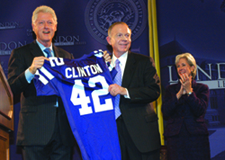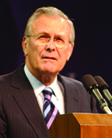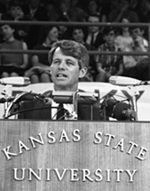History takes the stage
Landon Lecture Series remains among the most prestigious in the country
It's no surprise when a newsworthy lecture shows up in headlines for a few days. But when a lecture reappears in the news for months and even years, it's unusual. Unless it's a K-State Landon Lecture.
 "All the lectures get good publicity, but a few pop up in the news days, weeks and even years after they were presented," said Charles Reagan, who has chaired the Landon Lecture Series since 1984.
"All the lectures get good publicity, but a few pop up in the news days, weeks and even years after they were presented," said Charles Reagan, who has chaired the Landon Lecture Series since 1984.
The June 2008 issue of Vanity Fair magazine devoted a section to the March 18, 1968, lecture by Robert F. Kennedy, titled "Conflict in Vietnam and at Home." The magazine's focus is typical of the long-lasting value of the Landon Lectures, Reagan said.
(This year's first Landon Lecture, by the former president of Mexico, Vicente Fox, will take place at 3:30 p.m. Sept. 23 in McCain Auditorium.)
"The Landon Lectures remain one of the most prestigious series in American colleges and universities," said Jon Wefald, university president. "The Landons have a long history of attracting speakers who have something important to say." The series has played host to some of the most important figures in public life in America over the past 40 years.
Among recent newsworthy visitors, Reagan cited the 2008 lecture by Gen. Michael Hayden, director of the Central Intelligence Agency, and the 2007 lecture by Robert Gates, secretary of defense.
"Both made major policy speeches here," Reagan said. "The fact that these were made outside Washington added to the drama."
 Sometimes timing is serendipitous for K-State. Donald Rumsfeld spoke on Nov. 9, 2006, the day after he announced he was stepping down from his post as George W. Bush's first secretary of defense.
Sometimes timing is serendipitous for K-State. Donald Rumsfeld spoke on Nov. 9, 2006, the day after he announced he was stepping down from his post as George W. Bush's first secretary of defense.
"There was speculation in the media over whether Rumsfeld would still come to speak," Reagan said. "But he did and he drew a huge crowd." Rumsfeld also was in town because Gen. Richard Myers, former chairman of the Joint Chiefs of Staff, was being honored with a building named for him at K-State.
The 2006 lecture by President George W. Bush also attracted attention long after the speech.
"Bush was quoted extensively because the atmosphere at K-State allowed him to be himself," Reagan said.
The series gets access to A-list speakers mainly through connections, Reagan said.
"James Pearson was a senator from Kansas in 1968. He went to law school with Bobby Kennedy, and that's why Kennedy came to K-State to give a Landon Lecture," Reagan said. "It was his first speech after he announced he was running for president."
Since nearly all Landon Lectures are available online to view, hear or read, the older lectures reach a new audience each time a news cycle mentions them.
 More than 1,000 hits are recorded each month on the Web site that links to audio and video archives, at http://ome.ksu.edu/lectures/landon/
More than 1,000 hits are recorded each month on the Web site that links to audio and video archives, at http://ome.ksu.edu/lectures/landon/
Inaugurated in 1966 by former K-State President James A. McCain, the series is a tribute to the late Alfred M. Landon.
Landon was sworn in as governor of Kansas Jan. 9, 1933, and served two terms. Later he was the 1936 Republican Party nominee for president. On Dec. 13, 1966, he delivered the first lecture in the series: "New Challenges in International Relations."
"Alf set the tone and direction with his first lecture," Reagan said. "It was prophetic in warning the United States to avoid war in Vietnam, and suggesting we normalize relations with China.
"He made important statements. The speakers who followed him have done the same."
Photos: Distinguished visitors to the Landon podium have included Bill Clinton and Donald Rumsfeld. Bobby Kennedy spoke on March 18, 1968, shortly after he had announced his run for the presidency.